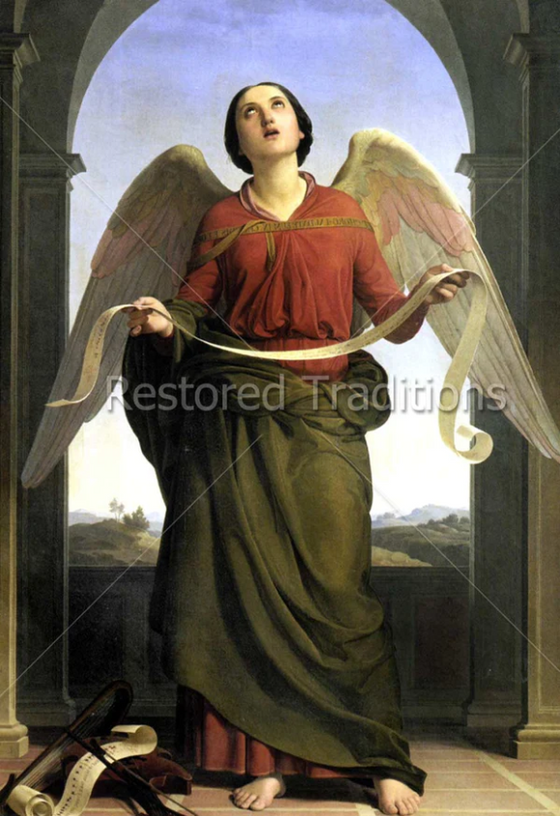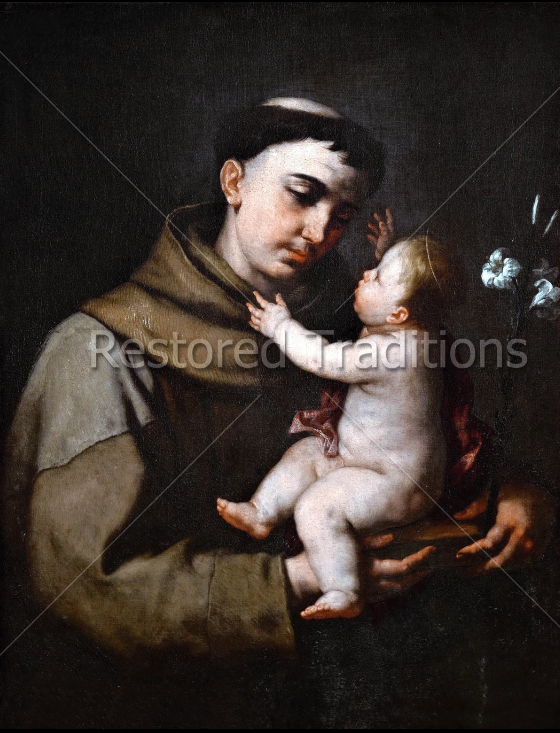
We've found this image (Ecce Homo – Behold the Man) to be helpful for meditation on the Passion.
One of the reasons it is such an aid is because it leaves much for the imagination. Specifically, we don't see the faces of Jesus or Pilate from the front (as is usually the case in Catholic art). Instead, we have a view from the rear of the scene, as if from the perspective of a roman servant.
What pulls the eye in right away, of course, is the central scene of Pilate displaying Jesus Christ to the Jews and saying 'Behold the Man'. Even if the title of this painting wasn't "Ecce Homo," it's still simple to derive that this is indeed the moment the painting captures. Notice the motion of Pilate's arm, pointing towards Jesus Christ, the crown of thorns barely visible on Christ's head, and the exposed back indicating the recent flagellation.
When the eye wanders more through the art painting, it will notice the most visible face in the entire image: that of the woman on the right. The look of anguish on her face, her outstretched arm embracing her friend (or servant perhaps) for emotional support—all indicate that this figure would be none other than the wife of Pontius Pilate.
"And as he (Pontius Pilate) was sitting in the place of judgment, his wife sent to him, saying: Have thou nothing to do with that just man; for I have suffered many things this day in a dream because of him." Matt 27:19
If it was her explicit wish for her husband to have nothing to do with a just man, then her emotional pain displayed in the picture makes perfect sense. The moment Pilate begins to announce that he has tortured the Christ, her heart sinks as the realization truly sets in that her husband displayed cruelty to the just man, despite her warnings. She turns from his side and begins slowly withdrawing—the moment captured in this art painting.
We can relate to the agony of Pilate's wife by inserting how our own sins have caused the suffering of Jesus Christ. The brilliance of the perspective of Pilate's wife is that she, apparently, had no idea that Jesus was God or that He was dying for ours sins. If she had so much sorrow simply because she sensed that something was awry and unjust, imagine how great her sorrow could have been had she known the sublime and grim reality of what was happening before her eyes.
Title: Ecce Homo (Behold the Man) | Artist: Antonio Ciseri
Brilliant depiction. Can anyone explain the anatomy of the configuration of the hands of JESUS?
I pretty much agree with your analysis. Even, possibly, Pilate’s wife had her hand on her servant’s shoulder to steady her, so great was her distress. In those days many pagans, as I assume the woman was, believed strongly in dreams and the veracity and import they carry.
This painting has always been a facination to me. It was genius – in my humble opinion – not only for the wife of Pilate and the message she gives tot the viewing audience, but also in in capturing such realism and power. The artist so brilliantly depicted Christ’s humble acceptance of his role as Savior, while showing the governor’s self aggeandised blindness.
I also like the Rembrandt quality, althouh not quite to the older artist’s level, how the work “freezes a mood” of emotional strength in mere oil and canvas. One of my favorite!
joekeck.com
Comments will be approved before showing up.


Discover the Timeless Treasures of Rare Catholic Art
Immerse yourself in the rich history and spiritual depth of rare Catholic art with Restored Traditions, the premier source for digitally restored masterpieces. As an art director or creative director, you understand the power of visually compelling imagery to captivate and inspire your audience. Our extensive collection of royalty-free and copyright-free Catholic art offers you an unparalleled opportunity to elevate your projects with works of historical significance and profound beauty.
Since 2006, we have been dedicated to preserving and sharing the artistic legacy of the Catholic Church. Our team of expert digital restorers meticulously brings these rare pieces back to life, ensuring that every brush stroke and intricate detail is captured in high-resolution digital format. With over 30,000 satisfied customers worldwide, we have established ourselves as the trusted choice for those seeking authentic and impactful Catholic art.
One such masterpiece in our collection is the artwork depicting the life and legacy of St. Anthony of Padua. Born Fernando Martins de Bulhões in Lisbon, Portugal, St. Anthony’s journey from an Augustinian monk to a revered Franciscan preacher is a testament to his unwavering faith and spiritual wisdom. By incorporating the artwork of St. Anthony and other rare Catholic pieces into your designs, you can create a unique and meaningful connection with your audience.
As an art director or creative director, you have the power to shape the visual narrative of our time. Let restoredtraditions.com be your partner in telling stories that resonate with the human spirit. Explore our extensive selection of rare Catholic art today and unlock a world of inspiration and historical significance for your projects.
Patrick Werick
Author